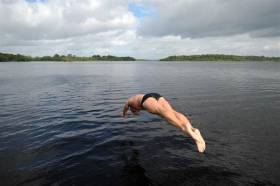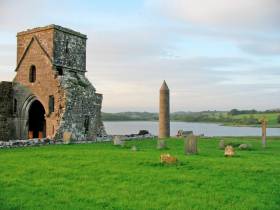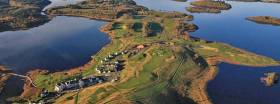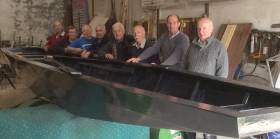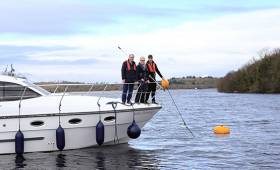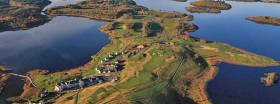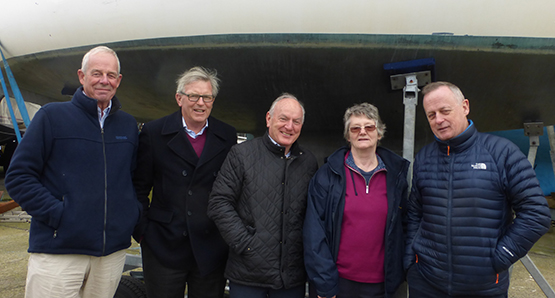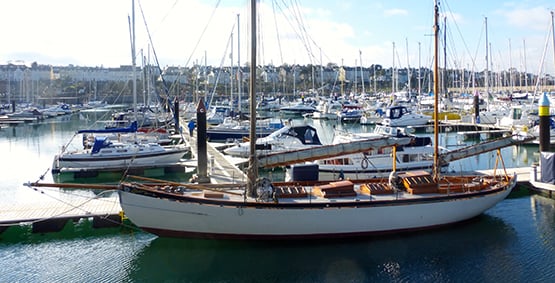Displaying items by tag: Lough Erne
Couch To 5K Open Water Swim Challenge Comes To Lough Erne
#Swimming - Waterways Ireland has welcomed Maureen McCoy and Paul McCambridge’s efforts to bring their Couch to 5K Swim Challenge to Lough Erne.
The 10-week programme is designed to bring swimmers out of the pool and into the open water. The scheme will run over five fortnightly sessions from June to August 2017 and will provide swimmers with the knowledge, skills and training to ultimately complete a 5km swim event.
The coaches are Maureen McCoy, an English Channel soloist, and Paul McCambridge a North Channel relay swimmer. Both Maureen and Paul will guide swimmers through from the first outdoor swim to competing in this challenging event.
The Couch to 5K Swim Challenge is aimed at swimmers of varied levels who wish to either start swimming outdoors or improve their fitness and speed for events. The coaches have designed a programme that will challenge each swimmer and allow them to acquire new skills, no matter what their starting point.
The five fortnightly sessions will take place on Saturdays starting on 3 June, and will increase in intensity with the aim of completing a 5km swim in August.
There is a fee of £30 for participation. Register your interest at [email protected] or wildswim.wordpress.com.
Donegal Woman Drowns In Lough Erne Tragedy
#LoughErne - A Donegal woman drowned after a boating accident on Lough Erne late on Wednesday night, as RTÉ News reports.
The woman is believed to have fallen overboard from a hired vessel she and her husband and children has been using for the Easter holidays.
It’s thought the 35-year-old slipped from the deck while checking the boat was tied to the jetty at Devenish Island, near Enniskillen, in the early hours of Thursday 13 April.
The Belfast Telegraph adds that the woman’s husband dived into the lough to attempt a rescue after hearing a splash but could not find her in the dark.
Her body was recovered by emergency services 40 minutes later just metres from the stern of the boat. CPR was attempted at dockside but she was later died in hospital.
The Belfast Telegraph has more on the story HERE.
Brexit Is ‘A Positive’ Says New Lough Erne Resort Manager
#LoughErne - New Lough Erne Resort general manager William Kirby sees Brexit as another opportunity to build the Lough Erne brand and the golf resort’s reputation as a worldwide destination.
Speaking to the Belfast Telegraph, Kirby says he is under no illusions as to the status of what was among the top tier of Northern Ireland’s luxury resorts 10 years ago, but had become “downtrodden” since going into administration four years later.
Kirby was appointed last year by the new American owners of the resort, which boasts a Nick Faldo-designed golf course, following successful stints at Mount Juliet and Kilkenny’s Lyrath Estate.
And his first move was to hire a new sales and marketing team, whose efforts have already seen a turn-up in guest numbers.
Despite the resort losing hosting rights for this summer’s Irish Open, Kirby is confident that he and his team can do what’s necessary to attract similar “silver bullet” events back to Lough Erne in future. The Belfast Telegraph has much more HERE.
#InlandWaters - Waterways Ireland completed the first week of its pilot 'Water Project' for post-primary schools last Friday 30 September.
Ninety students and teachers from four second-level schools in Co Fermanagh are engaged in water-based learning activities on Lough Erne as part of the two-week pilot educational project which concludes tomorrow (Friday 7 October).
Pupils and teachers from St Fanchea's College, St Aidan's High School, Devenish College and St Joseph's College undertook the two-day programme at Waterways Ireland's headquarters in Enniskillen, where they took part in biodiversity workshops and discovered some of the many fascinating water-based creatures, birds and aquatic plants that exist along the shoreline of Lough Erne.
They also rowed a 33ft currach in the Bronze Age style, and learned the techniques of angling, before diving into kayaking and a heritage workshop in Fermanagh Castle Museum earlier this week.
Initial feedback from both students and teachers has been positive, according to Waterways Ireland, which adds that at the end of the two-week pilot all feedback from partners and participants will be gathered to inform an evaluation report and future development of the project in the months ahead.
The Water Project has been developed and implemented in partnership with Row the Erne; Erne Paddlers; Inland Fisheries (DAERA) and the National Coarse Fishing Federation of Ireland; Fermanagh Castle Museum; RSPB and the Ulster Wildlife Trust.
Waterways Ireland has ongoing educational work with primary schools centred on the waterways. The Water Project aims to promote awareness and knowledge of the importance of Lough Erne and access to its many recreational activity opportunities for secondary students.
In early 2015 a number of Fermanagh people, some whose families go back for generations working and living on and around Lough Erne, were brought together to discuss their concerns that the history and heritage of wooden boat building on and around Lough Erne had all but disappeared writes Fred Ternan of Lough Erne Heritage.
All of the people in attendance had direct connections with wooden boat building on Lough Erne and in Fermanagh. Many more have joined since.
It was discussed and agreed that since the last wooden boats were built about 1970 much work would need to be done to retain what information was left and that this research would need to be done very soon. It was agreed that a community group calling itself Lough Erne Heritage would be formed with a constitution and trustees and whose aims would be to promote and preserve the history and heritage of wooden boat on and around the entire River Erne from its source in County Cavan, through Fermanagh to its estuary in Donegal and would focus on the people who built and used them.
Work would concentrate mainly on the traditional boats, the log boat (coite) or dugout canoe, the Lough Erne Cot and the traditional Lough Erne Clinker built rowing boat. All information gathered and confirmed on other significant boats brought to or built on the lough would also be saved, the emphasis again on who built and used them. Since almost all of those boats have disappeared efforts would be made to find drawings etc and save these.
All information gathered so far has been saved centrally and when we set up our website will be shared with all. Displays, exhibitions and talks have been held with more to come and much information has been gained as a result.
Work has already begun on building examples of the traditional boats with one of two Lough Erne Cots almost ready to be launched. Two identical Lough Erne Cots are being built with the intention of reintroducing Cot Racing to the lough. These were very serious contests carried out in a number of places around the lough in the 1800s. So serious indeed, legend has it that on at least one occasion, a competitor's cot was sabotaged the night before the event. This took place on his island on the shore not far from the house. Notices for such cot races are held showing the courses to be rowed and after the launch of the two cots in August racing will commence.
Relationships have been formed with other like minded groups and it is hoped to extend this throughout Ireland. The first traditional boat, the hollowed out tree trunk, log boat or dugout has been found in many places throughout Ireland with some dated carbon dated to between three and four thousand years BC. Many local cots are descended from such craft. With this common denominator shared by all groups preserving and developing an interest their local traditional boat, it is hoped that arrangements eventually be put in place to display traditional boats at venues rotated around Ireland.
The Lough Erne Cot is unique to the Erne System and ranged in size from about 12 feet in length to quite massive cots 55feet long. With the lough being heavily populated around the shore and on the islands, quite unique in itself, the smaller cots were used for getting about, doing the shopping for instance. The larger cots were used for transport and as ferries, bridges were a fairly recent addition to the lough. Many of the large cots transported stone to build the houses and towns and turf to fuel them. There was continuous traffic along the length of the lough transporting sand turf and freight brought into the port of Ballyshannon. The freight from Ballyshannon was transported overland to Belleek where it was put on cots and shipped to Enniskillen and various other parts of the lough and Fermanagh.
On the journeys along the larger Lower Lough sails were often used to ease the workload of the two man crew.
It's not surprising that the regular regattas were an eagerly anticipated attraction and a way of forgetting for a day the very hard work of earning a living from the lough. The planned re-introduction of cot racing will be a means whereby the efforts of those in the past, using Lough Erne Cots to help build and develop the area can be remembered.
Recently, i.e, in the last 50 years, Lough Erne Cots were used to transport cattle up until the late 1980s, the last cot used for this being able to carry 12 to 14 cattle at a time.
Transport on the lough is now done by steel ferries some of whom resemble the shape of a Lough Erne Cot.
Whilst work is continuing on building two 22 feet long Lough Erne Cots other events are being planned. An Art and Photographic exhibition is being organised for the 28th, 29th and 30th of July in Enniskillen Library, the theme being Lough Erne and its Wooden Boats. This follows a successful display about wooden boat building held there last year. Along with the exhibition a number of traditional wooden boats will be on display outside the library on Saturday the 30th of July including one of the recently built Lough Erne Cots.
Lough Erne Heritage owns, has access to and the use of a substantial amount of boats, artefacts, images and stories including maps showing which islands were occupied and the routes the inhabitants used. Substantial detail on the boat builders of the past is also held and it is hoped to soon have this available to the public.
This will ensure that this interesting but almost forgotten part of the history and heritage of Lough Erne and the surrounding area is brought to the attention of all and preserved for the future.
Buoy Moorings Provide New Experiences for Boaters on Lough Erne
Waterways Ireland has installed a new style of moorings on Upper and Lower Lough Erne to create an opportunity for boaters to use and experience the waterway differently.
The 18 new moorings across Upper & Lower Lough Erne are yellow mooring buoys that are permanently attached by chain to an anchor on the lake bed, to which a boat may tie up as an alternative to mooring at a jetty or deploying an anchor.
To moor up, a vessel should approach the yellow mooring buoy slowly from downwind. Using a boat hook lift up the pick-up buoy and attached rope out of the water to reach a steel ring. The forward mooring rope should be passed through the steel ring and tied securely from a deck cleat or other strong boat fixing. Users are advised to wear a lifejacket.
German tourists Mark and Melinda using the mooring at Castle Archdale this week on Manor House Marine's Noble Emperor declared it 'really easy'. JP McCaldin from Aghinver Boat Company indicated the moorings would be recommended to their customers as they 'were so simple to use'.
Waterways Ireland's, Director of Business Development, John Boyle, stated "Waterways Ireland is continuing to invest in providing new experiences for waterway users on Lough Erne. The buoy moorings across the Upper and Lower Lake are currently located in 18 locations. Feedback and usage rates will dictate if Waterways Ireland should increase their provision to other locations."
The locations have been chosen to provide safe, sheltered moorings in quiet locations that that will interest boaters with no negative impact or disturbance to bird, fish or mammal species or their habitat. These locations are not intended to give the boater egress to the land, but to provide a safe mooring opportunity away from other waterways users and offering a more intimate connection to nature, which some boaters are seeking. On Upper Lough Erne the moorings are located in Quivvy Lough, Trial Bay, Gole Wood, Creaghmacwallen Island and Tamlaght Bay. On Lower Lough Erne they can be found at Devenish, Inish Fovar, Blaney Bay, Castle Archdale, Strongbow and Rossmore Bay.
In selecting the locations for these moorings Waterways Ireland has paid particular attention to the provision of safe navigation and a safe mooring in a range of water depths and wind directions and the avoidance of overhead electric wires (for craft under sail). Waterways Ireland has also taken into account the weight of craft in designing the mooring anchors to cater for the heaviest cruisers presently on the navigation.
Waterways Ireland Erne Operation staff undertook the design and installation of the moorings across Upper & Lower Lough Erne and are looking forward to receiving feedback from users to [email protected].
Maps and information showing the buoy mooring locations can be found on www.waterwaysireland.org .
Buoy Moorings: Frequently Asked Questions
What is a Buoy Mooring?
A buoy mooring is a mooring buoy that is permanently attached by chain to an anchor on the lake bed at which a boat may tie up as an alternative to mooring at a jetty or deploying an anchor.
Why is Waterways Ireland installing buoy moorings?
Waterways Ireland is installing this type of public mooring to offer boaters an alternative to mooring at a jetty. The locations have been chosen to provide safe, sheltered moorings in quiet locations that will not result in a negative impact or disturbance to bird, fish or mammal species or their habitat. As only one boat can moor at a time, the buoy mooring offers a boater a more natural experience which some boaters are seeking.
What locations have been selected for buoy moorings?
The locations for which Waterways Ireland has sought planning permission are Quivvy Lough, Trial Bay, Gole Wood, Creaghmacwallen Island and Tamlaght Bay on Upper Lough Erne and on Lower Lough Erne at Devenish, Inish Fovar, Blaney Bay, Castle Archdale, Strongbow and Rossmore Bay. Maps are available showing the exact locations.
Are these the only locations in which buoy moorings will be considered?
Waterways Ireland will pilot buoy moorings at these locations and will assess the level of use and listen to boaters in relation to other locations they would like considered for future moorings.
Why has Waterways Ireland chosen these locations?
In choosing the proposed locations Waterways Ireland has sought comment from user groups, the Environment Agency, Inland Fisheries and the RSPB. It is Waterways Irelands intention to provide safe moorings at locations that that will interest boaters but that will not result in a negative impact or disturbance to bird, fish or mammal species or their habitat.
These locations are not intended to give the boater egress to the land, but to provide a safe mooring opportunity away from other waterways users and offering a more intimate connection to nature.
How do you use a buoy mooring?
Each buoy mooring will have a pick-up buoy attached to the mooring buoy. The boat should approach the mooring slowly from downwind. Lift the pick-up buoy using a boat hook and draw it upward til a steel ring is exposed. Pass the forward mooring rope through the ring and back over the boats fairlead and attach to the deck cleat.
What bye-laws apply to buoy moorings?
The Lough Erne Navigation By-laws apply to the buoy moorings, including the 48hour mooring rule.
Has Waterways Ireland considered the environmental consequences of boaters mooring in these locations?
Planning permission is only being given in locations where the moorings will have no negative impact on the environment.
Are these locations 'safe'?
In selecting the locations for these moorings Waterways Ireland has paid particular attention to the provision of safe navigation and a safe mooring in a range of water depths and wind directions and the avoidance of overhead electric wires (for craft under sail). Waterways Ireland has also taken into account the weight of craft in designing the mooring anchors and intends to cater for the heaviest cruisers presently on the navigation.
Lough Erne Loses 2017 Irish Open
#LoughErne - It's been confirmed that the Lough Erne Resort will no longer host next year's Irish Open golf tournament.
As reported on Afloat.ie earlier this year, changes in the European golfing scene had cast doubt on the Fermanagh lakeland resort hosting of the 2017 event in after getting the nod two years ago before its purchase by American business tycoon Tony Saliba.
Those doubts were confirmed last week, as the News Letter reports, with a statement from the Lough Erne Resort that it is "extremely disappointed" that the European Tour has announced a change in venue.
It's understood that the sport's new European bosses favour a links course for the annual Irish Open, with Portstewart Golf Club on the North Coast a likely candidate.
The News Letter has more on the story HERE.
Belfast Lough Celebrates 150 Years of Organised Sailing in Style
The development of organised sailing in Ireland seems to have spread northeastwards from the south and southwest coasts. Although the great chieftain Hugh Maguire had a fleet of pleasure vessels including sailing craft on Lough Erne in County Fermanagh in the 1500s, while the noted scientific polymath Sir William Petty found a sailing “pleasure boatte” on Dublin Bay to test his catamaran Simon & Jude against in 1663, it was on Cork Harbour that we find the first formal organisation with the foundation of the Water Club in 1720 writes W M Nixon.
Before the advent of good roads, and long before the railways arrived, Ireland’s myriad waterways and lakes provided the best options for the inland transport both of goods and people, and inevitably some gentrifried working boats were also used for relaxation, and the next club to be formed was Lough Ree YC in 1770. By 1820, the world’s first club specifically organised to provide racing came into being on Lough Erne, then nearby on Lough Gill in Sligo, the Ladies’ Cup was first raced for in 1822, and it still is cometed for today, though now at Sligo YC’s sea base at Rosses Point.
In the pre-famine era before 1845, the relative affluence of the west and southwest of Ireland supported the landed classes in yacht ownership, and a regatta at Kilrush in the Shannon Estuary in 1828 saw the establishment of the Royal Western of Ireland YC, which at its height in 1838 had a fine fleet of 18 cutters – some of quite substantial size - based in Kilrush Creek and spreading outwards to families along the coast such as the O’Connells of Tralee, Cahirsiveen and Derrynane.

The Game Changer. Dun Laoghaire’s first regatta in 1828 set Dublin Bay on course to be the pace-setter in yachting development.
But 1828 also saw the first regatta to be staged at the new harbour of Kingstown on Dublin Bay, and the success of this provided an unrivalled focus for the development of new ideas in sailing not only in Ireland, but at an international level. Whereas other sailing area saw the locations of activity spread across several centres large and small, in Dublin Bay there was just this one big powerhouse of sailing development through which all the recreational nautical energy of the capital city was channeled. The Royal Irish YC came into being in 1831, the Royal St George YC got going in 1838, and soon Kingstown outstripped most comparable centres at home and abroad, particularly in racing development.
Yet at this time Belfast was already the fastest-expanding city in Ireland, and it was moreover a growing centre of genuine wealth-creating manufacturing industries and ship-building enterprises. Why wasn’t Belfast Lough in the forefront of sailing development by the 1850s?
It wasn’t as though there wasn’t a small but time-honoured local recreational sailing tradition on Belfast Lough. During the 1780s and 1790s, Belfast had been a place of liberal ideas and social innovation, and a small group of recreational sailors led by Henry Joy McCracken pioneered cruising from Belfast Lough to the west coast of Scotland and the Hebrides. But then in 1798 McCracken also led the rising of the United Irishmen, and when it was suppressed he was executed by hanging in the Cornmarket in Belfast on land which his grandfather had donated to the town.
Subsequently, the Presbyterian majority in the north turned in on themselves and concentrated on commerce and manufacture and literally minding their own business. But though, as prosperity returned, a small group of McCracken’s former shipmates formed the Northern Yacht Club in Belfast Lough in 1824, Belfast’s rapid industrial expansion made the port very limited as a yacht harbour, thereby limiting their growth.
Belfast Lough may have provided splendid sailing water, but it was very poorly served by other smaller harbours, so the Northern Yacht Club members often found themselves sailing to the more congenial and well-serviced shores of the Firth of Clyde. They soon formed a Scottish branch, and by 1838 the Royal Northern Yacht Club - as it was to become, with an impressive clubhouse in Rothesay - had taken over the few remaining assets of the Belfast Lough branch, and that was the end of any club in the Lough for another quarter century.
Yet any student of sailing history will know that in 1856, Lord Dufferin from Clandeboye near Bangor on the shores of Belfast Lough made a celebrated voyage to the high Arctic with his schooner Foam. And in 1865, one of the most successful racing schooners of all time, the 99ft Egeria, was built for leading Belfast linen manufacturing magnate John Mulholland. So why wasn’t Belfast Lough sharing the sailing fame of other Irish centres such as Dublin Bay and Cork Harbour, which had shown their pre-eminence by staging the world’s first recognisably modern offshore race from Dublin Bay to Cork Harbour in 1860?
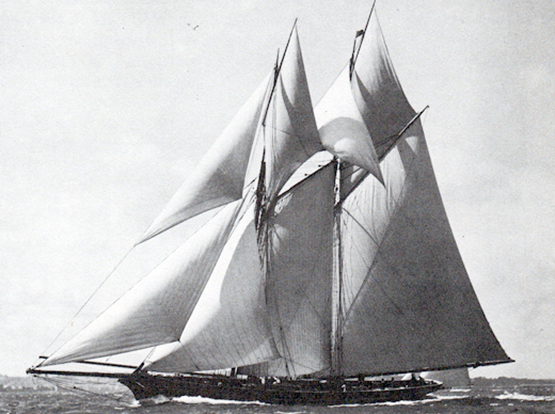
The extremely successful racing schooner Egeria was built for Belfast business magnate John Mulholland in 1865, but she was seldom if ever in Belfast Lough
The simple answer seems to be that in its period of hyper-growth, the business of Belfast was business, and sailing for recreation was not a Belfast business. Those who expected to sail at the highest level did so elsewhere, and once the Belfast to Dublin railway had been connected in 1855, it was as handy for the more affluent would-be yachtsmen to avail of the proper facilities in Dublin Bay rather than risk their yachts on exposed moorings in Belfast Lough, where shore facilities were still woefully lacking.
But in time the rapid rise of an energetic middle class in Belfast saw increasing demand for sailing amenities and events nearer home. We know that a regatta of some sort was staged at Holywood immediately east of Belfast on the lough’s south shore in 1854, and it was at Holywood – despite the little town’s drying anchorage – that the first club since the Northern YC in 1824, the Hoywood Yacht Club – was formed in 1862, and it still exists, Belfast Lough’s senior club.
Then in 1866 a regatta was staged from the only half decent harbour on the lough, at Carrickfergus, and the organisers were pleasantly surprised by the number of boats which turned out, boats whose owners had squirrelled out bits of shelter for their craft in small places like Donaghadee, Groomsport, the tiny drying harbour at Bangor, in the open roadstead off Cultra, in the cleaner parts of Belfast docks, in Carrickfergus itself, and round the corner in Larne Lough.
From this there immediately emerged the Carrickfergus Amateur Rowing & Sailing Club, but mostly to cater for local demand. But soon afterwards in Belfast the Ulster Yacht Club was formed by a group of affluent businessmen, professionals, industrialists and landowners with Lord Dufferin as their Commodore. By 1869 he’d seen to it that they’d become the Royal Ulster Yacht Club, but it was an organisation which was resolutely to function without a clubhouse until 1899, nevertheless growing in prestige with every passing year.
Thanks to that focus of interest through the Carrickfergus Regatta of 1866, 2016 will see double celebrations on Belfast Lough with the 150th Anniversaries of both Carrickfergus Amateur Rowing and Sailing Club (which everyone knows as Carrick Sailing Club), and the Royal Ulster Yacht Club, which since April 1899 has been based in an impressive Arts & Crafts clubhouse on an eminence above Bangor’s waterfront.

The RUYC clubhouse was built in 18 months and opened in 1899 in order to be ready for Thomas Lipton’s first America’s Cup campaign
When the clubhouse was built, the harbour at Bangor was still rudimentary, but the sailing was great. However, since 1984 Bangor Bay has been turned into one of Ireland’s largest marinas, and now RUYC has the berthing facilities and the sailing water to stage major events with confidence.

Befast Lough provides excellent sailing water, but until the marina were built at Carrickfergus and Bangor, it lacked sheltered berthing

Carrickfergus Marina, with the harbour and its famous 12th Century castle beyond
Equally at Carrickfergus they also have a marina – in fact it pre-dates the one at Bangor – but as Carrickfergus was also the base of the extraordinarily productive yachtbuilder John Hilditch, albeit only from 1889 to 1913, one of the main parts of their celebration is going to be a Hilditch Regatta, not just for boats built by him such as Hal Sisk’s famous 1894 Watson cutter Peggy Bawn, the Howth 17s of 1898, and the RNIYC Fairy Class of 1901, but indeed for any classic or traditional craft, as Carrick has always been a spiritual home for the Old Gaffers Association.

Bangor Marina, with Ballyholme Bay beyond
Royal Ulster has meanwhile taken a different track through sailing history, for between 1899 and 1931, it was the club through which Thomas Lipton made his five America’s Cup Challenges, which has tended to obscure the fact that in the 1880s and 1890s, Belfast Lough with RUYC in a key role were setting a fantastic pace in sailing development, as they were trying to get a one design keelboat class going as long ago as 1889, and by 1895 they’d brought the Belfast Lough One Design Association into being with a determined young sailing man called James Craig as Honorary Secretary. Membership of the BLODA was open to any member of one of the recognised six clubs now based round the lough, but young Craig – who later went on to become Lord Craigavon, first Prime Minister of Northern Ireland in 1921 – was realistic in his expectations for the life of a strict one design keelboat class, and he only expected his members to be “in class” for three seasons.
By 1896 they’d the first two boats of a new 15ft LWL keelboat class designed by William Fife, no less, sailing on Belfast Lough, and before the summer was out the signs were good for a significant increase in numbers for 1897. James Craig was insisting the boats be built by John Hilditch, as he was noted for sticking strictly to the plans as drawn by the designer, whereas the builder of the first two boats for 1896, Paddy McKeown in the heart of Belfast, was always trying to improve on the designs, even if they were from Fife.

Regatta day for the Dublin Bay 25s – their design was inspired by the Befast Lough Class I boats.
But events overtook the programme. A group of affluent Belfast Lough movers and shakers decided they certainly wanted a One-Design class to the Belfast Lough ODA rules and designed by William Fife, but they wanted a proper sea-going boats with a cabin, around 37ft in hull overall length, and 25ft on the waterline, and setting a proper gaff rig with a jackard topsail rather than the modest little gunter rig set by the 15ft LWL boats, which were still referred to as Class I.
But as the idea for the bigger boats gained traction, they became Class I, and for a while the 15ft LWL boats became Class II, but after 1900 they were Class III when a 20ft LWL class came along. But meanwhile in late 1896 and early 1897, the Hilditch yard went mad, building nine of the new 25ft LWL boats. Even Lord Dufferin and his friends Lord de Ros and Lord Bangor came round from County Down in April 1897 to the tough town of Carrickfergus to see this remarkable new class of boats being built. And once the 25 footer had their first race off Carrickfergus on May 29th , they swung into action with what today would be called a series of promotional tours, as they did all of Clyde Fortnight after a stormy crossing of the North Channel, and then after being back in Belfast Lough for long enough to race the RUYC regatta, they headed south to Dublin Bay in late July and inspired the creation of the Dublin Bay 25 class.
1898 was when they were in their prime, and by 1899 some owners were aready invoking the “three season” rule to move on, but in fact the class continued to race actively – though sometimes with very depleted numbers – on Belfast Lough until the end of the 1909 season.

John Hilditch was very busy in 1897 – in addition to the Belfast Lough Class I boats, his yard also built this 56ft motoryacht Romance for A J Lepper, for whom he’d built Peggy Bawn in 1894.
We get some idea of the boat-building pace around Carrickfergus in the late 1890s when we realise that in 1897 John Hilditch and his men were also building a 57ft Dixon Kemp motor-yacht, the Romance, for A J Lepper, for whom they’d built Peggy Bawn so well in 1894, and no sooner was the Romance out of the way than they turned to the next job, the building of the first five Howth 17s which their owners were able to sail the 90 miles to their home port in April 1898.
So obviously there’s going to be quite a complicated programme around Belfast Lough in late June and early July this year. And as the Howth 17s are in the unique position of being a Hilditch class which is not Belfast Lough-based, they hope to be able to pay their respects at Carickfergus both to the memory of their builder and to the 150th Anniversary of the Carrickfergus club, while also being able to do full justice to the Classic One Designs Regatta, which RUYC will be staging from Friday June 24th to Sunday June 26th.
The Hilditch Regatta meanwhile is from the evening of Wednesday June 22nd to Saturday June 23rd, when the fleet heads from Carrickferus to Bangor for a sail-past as part of the Royal Ulster events, but with some of the Old Gaffers then returning to Carrick (after due celebrations in Bangor) as the Carrick event is seen partially as a follow-on to the Portaferry Sails & Sounds the previous weekend, which is very much an Old Gaffers event.
In Carrickfergus are (left to right) Nick Massey, Roddy Cooper, Tom Houlihan, CSC Commodore Wendy Moore, and Ian Malcolm. Photo: W M Nixon
But for classes like the Howth 17s, despite their antiquity proper racing is what it’s all about, so I tagged along with a reconnaissance group of Howth 17 eminences when they went up North to suss out the scene this week. And as the group included Nick Massey who re-energised the class when it was going through a flakey period in 1972, Ian Malcolm who is playing a key role in the class’s current revival such that they’ll have eighteen boats racing this year, Roddy Cooper who owns the Hilditch-built Leila, and Class Captain Dr Tom Houlihan, you can be quite sure there wasn’t a dull moment.
First call was with Wendy Moore at Carrickfergus, where she’s Commodore for the 150th as the club settle into the new clubhouse after a disastrous fire three years ago, and as she’s also the Marina/Boatyard Manager and the newest addition to the ranks of owners in the local thriving Ruffian 23 class, everyone was on the same wavelength.

You’ll always find it’s now in a carpark….Roddy Cooper and Ian Malcolm stand on the spot where their Howth 17s Leila and Aura were built in 1898, with Carrickfergus Castle in the background. Photo: W M Nixon
Then we swung by Royal North of Ireland Yacht Club at Cultra on the south shore of the lough, home to the Hilditch-built Fairy class against whom the Howth crowd regularly have inter-club races, and fortuitously met up with Northern Ireland Old Gaffers Association Chairman Gary Lyons for some very high-powered info exchange. As a result we round out this week’s blog with a photo which does justice to the Portaferry Sails & Sounds which he is organising in June.
Then on in haste for a sailing business lunch (delicious) at Royal Ulster YC with Vice Commodore Myles Lindsay, Rear Commodore Greg Taylor, Honorary Sailing Secretary Robin McKelvey and Press Officer Fiona Hicks, learning yet again that the RUYC clubhouse is such a store of sailing memorabilia that it’s a difffcult to concentrate on the formal agenda, but I think the Howth men and the Bangor men understood each other very well indeed.

Myles Lindsay, Vice Commodore RUYC

Robin McKelvey, Honorary Sailing Secretary RUYC
The RUYC people have a lot on their plate, for no sooner is the Classics Regatta out of the way than they gear up at the beginning of July for an assembly in Bangor of cruising boats from the ICC, the RCC, the OCC, the CCC and other associated organisations, followed by a 150th Anniversary Cruise-in-Company along the Antrim coast and on to the West Coast of Scotland and the Hebrides.
But for the recce group from Howth, now it was down to Bangor Marina where manager Kevin Baird couldn’t have been more obliging, but the Howth 17 men all fell in love with the classic ketch Morna berthed right next to the marina office, so Fiona and I had to speed them on their way to the exhibition of 150 Years of sailing in Bangor Museum.
The classic ketch Morna in Bangor Marina. Photo: W M Nixon
And then after that, duty done and work completed, I took them for the treat of the day, down among the hidden places of Strangford Lough to meet up with Kenny Smyth at his boatyard, which for any one who is into classic, vintage or traditional boats is heaven on earth. And of course it emerged that Kenny the King of the River Class, Whiterock’s historic Mylne-designed premier fleet, has recently become Commodore of Strangford Lough Yacht Club. So we headed for home into a gorgeous sunset having notched up two Commodores, one Vice Commodore, one Rear Commodore, one Chairman, one Honorary Sailing Secretary, two Marina Managers and one Press Officer. And if that’s not a good day’s work on the diplomacy and negotiating front, then I don’t know what is.
The eternal enthusiast. Kenny Smyth of Whiterock runs a boatyard, he is also Commodore of Strangford Lough Yacht Club, he is River Class champion, and he just loves talking about boats night and day. Photo: W M Nixon
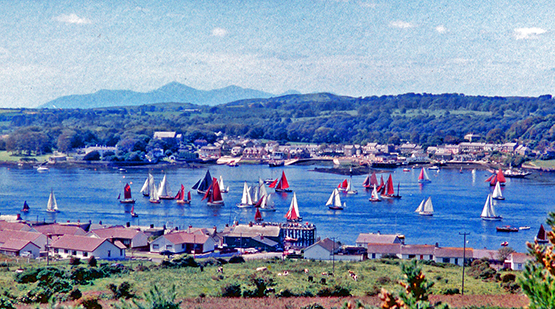
The promise of summer – the classic and traditional season in the north starts with Portaferry Sails and Sounds on June 16th.
Lough Erne's Hosting Of Irish Open No Longer Certain
#LoughErne - Changes in the European golfing scene have cast doubt on Lough Erne's hosting of the Irish Open in 2017.
The Faldo Championship Course on the lough's shores was given the nod in early 2014 to host Ireland's most prestigious golf event, which was held at Royal County Down last summer.
Since then the Lough Erne Resort was snapped up by American business tycoon Tony Saliba.
But now the News Letter reports that European Tour officials have backed away from a firm commitment after the emergence of new stakeholders in Rory McIlroy's Rory Foundation and sponsor Dubai Duty Free – and a changing of the guard at the executive level.
According to a European Tour spokesperson, new CEO Keith Pelly "has big, big ideas about what he wants to do and the Irish Open is a key part of that strategy because it is one of the biggest tournaments.”
The News Letter has more on the story HERE.
Flooding Remains 'Severe' As Shannon Levels Peak
#Flooding - Flooding in the Shannon catchment is still "severe" according to the National Emergency Coordination Group,
As RTÉ News reports, waters have risen by 2.5cm in the Athlone area, where the Shannon breached its banks before the weekend.
And levels expected to peak on the Lower Shannon later today (Monday 14 December) between Lough Derg and Limerick, which experienced serious flooding in parts of the city not normally affected.
However, as rain persists over coming days, counties in the South and South West remain at risk, as heavy rainfalls "could cause flooding in areas have had no flooding so far".
Meanwhile, at the other end of the waterway, Lough Erne burst its banks in the Enniskillen area at the weekend – rendering a number of roads impassable, as the News Letter reports.































